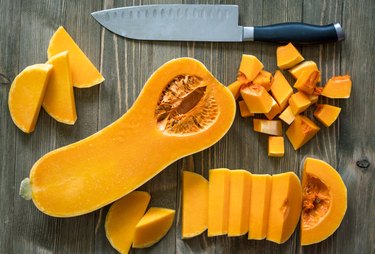
There are many ways to enjoy butternut squash, including squash soup, squash stew, dips, purees and pastas. This winter squash — known for its hard, pale yellow-orange skin and nutritional qualities that include high vitamin and mineral contents — is also delicious roasted or pureed.
Tip
To boil butternut squash, first peel off its tough outer skin, and then remove the seeds. Cube the squash, place it in a pot of boiling water, and cook until fork-tender, about 7 to 10 minutes.
Video of the Day
How to Boil Butternut Squash
The top three ways to cook butternut squash are boiling, roasting in an oven and irradiating in a microwave. A general method for preparing squash involves first peeling or cutting away its hard outer skin. To start, hold the squash steady against your chest (wearing an apron will protect your clothes) and, with a vegetable peeler, peel towards yourself.
Video of the Day
When all the skin has been removed, cut off both ends of the squash and, using a large knife, cut the squash in half lengthwise. Scoop the seeds and fibrous material out of the middle cavity with a spoon. Cut each section in half, quarter it, and then dice it into cubes.
To boil butternut squash, bring a large pot of water on the stove to a boil. Place the cut pieces of squash carefully in the pot, bring it back to a boil, and then lower it to a hard simmer. Cook the squash until fork-tender, about 7 to 10 minutes. Drain the water and let the squash cool.
After you boil butternut squash, you can mash it up with butter and salt and incorporate it into your dinner in place of, or in addition to, mashed potatoes. You can also puree it and use it in meals such as risotto, a creamy Italian rice dish that benefits from a smooth squash puree. Pureed butternut squash can be stirred into oatmeal, added to soups, or used in muffins and cakes instead of pumpkin.
How to Roast Butternut Squash
Roasting butternut squash brings out its inherent sweetness, which is enhanced by cooking at a high temperature. It can be further sweetened by adding a drizzle of maple syrup or honey, or sprinkle of brown sugar, before placing it in the oven.
You may roast butternut squash with its skin on or off. If you leave the skin on, halve the squash lengthwise and scoop out the seeds. Place each half on a lightly greased baking sheet — or on a sheet of parchment paper — with the flesh side up.
Heat the oven to 400 degrees Fahrenheit (the USDA gives a method for roasting at 350 degrees Fahrenheit) and season the squash with 1 teaspoon of olive oil, plus salt and pepper to taste. If you prepare a sweeter version, place 1 teaspoon of unsalted butter in the middle of each squash half, and drizzle 1 teaspoon of maple syrup or honey over each, or sprinkle each half with brown sugar.
Place the squash in the oven and roast it until the flesh is fork-tender, about 30 minutes. You may serve roasted butternut squash along roasted meats or roasted vegetables and legumes, or in an arugula salad with roasted beets.
You can also peel and cube butternut squash before roasting it. Heat the oven to 400 degrees Fahrenheit and cut the squash into 1-inch cubes. Arrange the squash cubes in one layer on a baking pan and drizzle them with olive oil, salt and pepper. Place in the oven and roast for 25 to 30 minutes, until tender. You may mash or puree your roasted butternut squash and use it in place of boiled squash purees.
Cook Butternut Squash in Microwave
Another cooking method for butternut squash is to use a microwave. After peeling the squash and removing its seeds, grease each cavity half with a teaspoon of unsalted butter (you could also use coconut oil). For a sweeter flavor, drizzle the squash with honey or maple syrup, or sprinkle with brown sugar.
Place the squash halves cut-side down on a piece of plastic wrap placed directly on a microwave-safe plate. Place in the microwave and cook on high, in 5-minute intervals, until the squash is completely soft and cooked through. This should take about 10 minutes. You may eat the squash directly from the skin, or scoop it out and place it on a dinner plate.
Whichever cooking method you choose, you'll benefit from butternut squash's nutritional benefits. These are detailed by the Harvard School of Public Health as the carotenoids beta carotene and lutein, considered flavonoids, which may help to protect human cells from the damaging effects of oxygen. Butternut squash also contains vitamin C, vitamin B6, fiber, magnesium and potassium.
A 1-cup serving of baked butternut squash is fat-free, as data from the USDA's Nutrient Database shows.
Read More: Disadvantages With Cooking in the Microwave